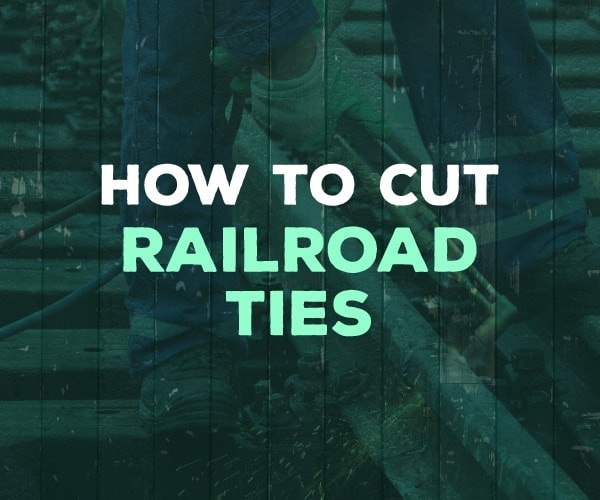Railroad ties are one of the strongest, sturdiest, and longest lasting building materials you could work with. But, all of that strength and durability comes at a cost. If you’ve ever worked with them in the past, you already know how difficult they can be to work with.
While using railroad ties for projects around the home is difficult, it isn’t impossible, and you can learn how to cut treated railroad ties by following the tips in this guide. It’s easy to become intimidated when working with these gargantuan pieces of wood, but fear not, by the time you’re finished with this guide, you should feel confident enough to tackle your project.
Table of contents
A Word of Caution
Before you get started on your project, there are a few things you’ll want to consider. The first of which is the difficulty of the work. Railroad ties are not only exceptionally large, but they often contain grit, rocks, and other materials embedded inside the tie for added durability. This makes them far more difficult to cut than an equivalent sized piece of wood.
Railroad ties are also coated with a carcinogenic compound called Creosote which is designed to weatherproof the ties. Creosote can also irritate your eyes, lungs, and skin if it comes in contact with you. Further, this compound can leach into the ground in the area where you’ve installed the ties.
In other words, if it’s possible, avoid working with railroad ties altogether. In many cases, the effort you’ll expend for this project will not equal the reward, and you should consider working with another material.
But, you may be forced to work with them, and therefore you’ll need to learn how to cut railroad ties. So, we’ll move right along.
What You’ll Need
Cutting railroad ties certainly isn’t easy, but it doesn’t require a ton of tools to do the job right. Here’s what you’ll need
- Electric or gas powered chainsaw
- Carbide tipped chainsaw chain (not required, but cuts more quickly than a standard chain)
- Chainsaw sharpener
- Two pieces of scrap wood (lumber 2x4s work great)
- Coveralls
- Work boots
- Work gloves
- Safety goggles
- Hearing Protection
- Tape measure
- Chalk
Step I: Setting up Your Work Area
First things first, you’ll need to set up the area in which you’ll be working. If possible, try and work somewhere close to where your concrete ties are set up so you can avoid lugging them around your yard.
Place your two pieces of scrap wood about three feet apart. Later, you’ll be putting your railroad ties on these pieces of wood, so you can elevate them as you cut. This will make it easier for you to cut through the ties, and also prevent the ties from binding as they’re cut.
Take your first railroad tie, and place it on the treated wood, so that it’s ready to cut.
Step II: Measuring
Depending on what you’re hoping to accomplish with this project, you may be able to skip this step. Many people who are learning how to cut old railroad ties are doing so to REMOVE them from their home, instead of using them in new construction. If that’s the case, no measurements will be necessary.
But, if you need to cut railroad ties to size for a new project you’re working on, you’ll want to use your tape measure and a piece of chalk to accurately measure and mark the cuts you need to make in each tie.
Step III: Cutting the Ties
Before you begin cutting railroad ties, take a moment to make sure that you’re working smartly and safely. Make sure you’re wearing coveralls, boots, safety goggles, hearing protection and gloves. As I mentioned, Creosote is nasty stuff, and you don’t want to get any of it on you.
When you’re ready, fire up your chainsaw and prepare to make your first cut. Cut straight through the tie to about ¾ of the total depth, and then take your chainsaw out and finish your cut by cutting upwards from under the tie. Doing so will help prevent the chain from binding.
As you cut, be especially careful. Railroad ties regularly have grit, small rocks and stones and other goodies lodged inside, and they can affect the way your chainsaw cuts. Work slowly and be vigilant and you shouldn’t run into any problems.
You’ll also need to keep in mind that because of the grit in the railroad tie, cutting through them can wreak havoc on your chain. If you’re making multiple cuts, you’re going to need to sharpen your chain periodically so that cutting railroad ties is easy.
Final Word
Railroad ties present some unique challenges that make them difficult to work with. But, the task is far from impossible. With some patience, good safety equipment, and your trusty chainsaw, you’ll be able to learn how to cut railroad ties with relative ease.
Follow the tips in this guide, and make sure you’re working slowly and carefully, and you’ll be able to conquer your railroad tie project. For some ideas on how you can use new railroad ties at your home, check out these helpful suggestions from HGTV.

